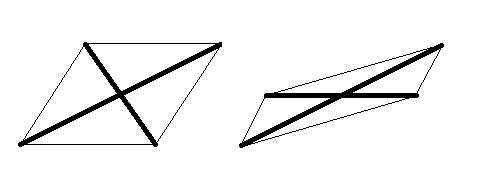How do you calculate the area of a parallelogram if only two diagonals are given?
1 Answer
It is impossible unless an angle is given.
Explanation:
It is impossible to calculate the area of a parallelogram if just two diagonals are given and nothing else.
It is however possible to calculate the area if additionally, the angle between the diagonals is given.
Why is this so?
Imagine that the two diagonals are wooden sticks that are being hold together with a nail in the middle but can rotate around that nail.
Here's an example with two different parallelograms that have diagonals of the same length.
(The long diagonal is duplicated, whereas the short diagonal has kept the length but is rotated around the "nail" in the middle).

As you can see on the example, depending on the angle between the diagonals, the parallelogram that is being spread between those wooden sticks can be very different one and can have completely different areas.
In the extreme case, where the two diagonals are almost parallel, the area is very small, whereas I believe that the largest area would be if the two diagonals were orthogonal.

